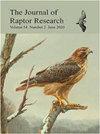筑巢耗费了白头鹰的时间,却没有影响其繁殖成功率或生产力
IF 1.2
4区 生物学
Q2 ORNITHOLOGY
引用次数: 0
摘要
建造巢穴会耗费鸟类的时间和精力,并可能影响繁殖成功率和生产力。对这些成本的确切性质和程度研究不足,特别是在猛禽物种之间。我们使用线性和广义线性混合模型研究了美国新泽西州白头鹰(Haliaeetus leucocephalus)在2009年至2021年期间筑巢的时间成本和繁殖成本。为了将筑巢成本与经验的影响区分开来,我们分别分析了新筑巢配对、已筑巢配对和已筑巢配对的繁殖表现和物候。我们还考虑了天气、年份和生态区的影响。与已建立巢穴或重复使用巢穴的鸟对相比,新建立巢穴的鸟对的成功率和产量普遍较低。然而,这些趋势在很大程度上可归因于已建巢对的产卵率更高。与重复使用巢穴的老鸟对相比,新鸟对和老鸟对的产卵、孵化和雏鸟羽化时间普遍推迟;新鸟对明显比老鸟对推迟产卵、孵化和雏鸟羽化时间。大西洋沿岸松树荒原中的领地配对的成功率和产量均低于其他生态区域的配对。产卵期前后的降水量较高可预测较低的筑巢成功率和生产率,但似乎不会影响物候期。产卵期前后气温升高也会降低筑巢成功率和生产率,并进一步影响物候期。在新泽西州,气候变化似乎正在推进白头鹰的繁殖物候期,并可能在本世纪末限制白头鹰的生产力,尽管我们预计密度依赖性将在这一时期之前调节并降低白头鹰的繁殖性能。繁殖成功率和生产率以及模型中年份的影响表明,新泽西州的白头鹰繁殖种群仍在健康成长。总体而言,我们的研究结果表明,筑巢会给白头鹰带来较小的时间成本,但不会对其繁殖成功率或生产率产生有意义的影响,这可能有助于为白头鹰巢穴和种群的管理提供信息。本文章由计算机程序翻译,如有差异,请以英文原文为准。
Nest Construction Costs Bald Eagles Time but not Breeding Success or Productivity
Constructing nests costs birds time and energy and may influence breeding success and productivity. The precise nature and extent of these costs is understudied, particularly among raptor species. We used linear and generalized linear mixed models to examine the time and reproductive costs of nest construction to Bald Eagles (Haliaeetus leucocephalus) in New Jersey, USA, from 2009 to 2021. To differentiate nest construction costs from the influence of experience, we separately analyzed the breeding performance and phenology of new pairs constructing nests, established pairs constructing nests, and established pairs reusing nests. We also considered the influence of weather, year, and ecoregion. New territorial pairs building nests were generally less successful and productive than established pairs building or reusing nests. However, these trends were largely attributable to a greater egg-laying rate among established pairs. Nest building pairs, new and established, were generally delayed in egg laying, hatching, and nestling fledging compared to established pairs reusing nests; new pairs were notably more delayed than established pairs building nests. Territorial pairs in the Atlantic Coastal Pine Barrens were less successful and productive than pairs in other ecoregions. Higher precipitation around the egg laying period was predictive of lower nest success and productivity rates but did not appear to affect phenology. Higher temperatures around this period also lowered these rates, with the further effect of advancing phenology. In New Jersey, climate change appears to be advancing breeding phenology and could constrain productivity by century’s end, though we anticipate that density dependence will regulate and lower Bald Eagle breeding performance prior to this period. Breeding success and productivity rates, as well as the effects of year in our models, indicate that New Jersey’s breeding Bald Eagle population is still healthy and growing. Overall, our results indicate that nest construction imposes minor temporal costs on Bald Eagles but does not meaningfully affect their breeding success or productivity, which may help inform management of Bald Eagle nests and populations.
求助全文
通过发布文献求助,成功后即可免费获取论文全文。
去求助
来源期刊

Journal of Raptor Research
生物-鸟类学
CiteScore
2.30
自引率
17.60%
发文量
61
审稿时长
>12 weeks
期刊介绍:
The Journal of Raptor Research (JRR) is an international scientific journal dedicated entirely to the dissemination of information about birds of prey. Established in 1967, JRR has published peer-reviewed research on raptor ecology, behavior, life history, conservation, and techniques. JRR is available quarterly to members in electronic and paper format.
 求助内容:
求助内容: 应助结果提醒方式:
应助结果提醒方式:


